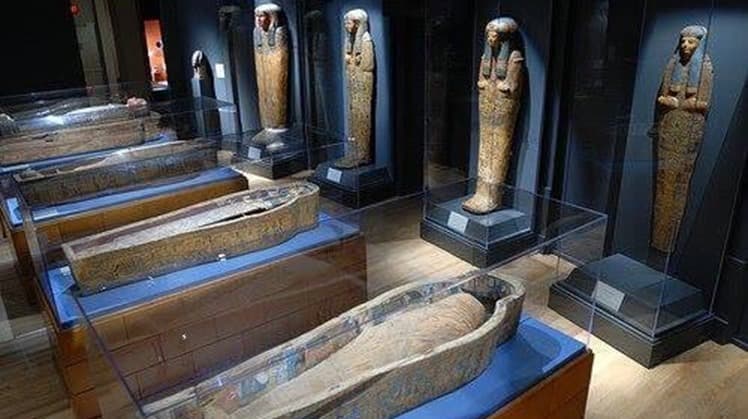
Step into the extraordinary world of the Hall of Mummies at the Egyptian Museum in Cairo, where ancient history comes alive. Immerse yourself in the haunting beauty of the preserved remains of pharaohs, queens, and other prominent figures from Egypt's glorious past. This mesmerizing collection offers a fascinating glimpse into the lives of these ancient rulers and the intricate funerary practices of the time.
As you wander through this hallowed hall, you'll marvel at the incredible state of preservation of these mummies, some of which date back over 3,000 years. Each mummy is a testament to the advanced embalming techniques and beliefs in the afterlife held by the ancient Egyptians. The hall showcases a diverse range of mummies, from the iconic Ramses II to lesser-known figures, each with their own stories to tell.
The Hall of Mummies in the Egyptian Museum is a treasure trove of history and a testament to the remarkable civilization that once thrived on the banks of the Nile. Step into the shadows of the past and be transported to a time long gone, in this captivating journey through ancient Egypt
Mummies hold a significant place in ancient Egyptian culture and religion. The process of mummification was not just a means of preserving the body but also a way to ensure the eternal life of the deceased in the afterlife. The ancient Egyptians believed that the body needed to be preserved to allow the soul to recognize it and continue its journey in the afterlife.
The process of mummification was a complex and intricate one. It involved removing the internal organs and treating the body with natron, a type of salt, to dry it out. The body was then wrapped in layers of linen bandages and placed in a coffin or sarcophagus. The elaborate rituals and ceremonies associated with mummification were performed by skilled embalmers, who followed a strict set of guidelines to ensure the preservation of the body.
Mummies were not only reserved for pharaohs and royalty but also for individuals from all walks of life. The preservation of the body was considered crucial for the deceased to have a successful journey in the afterlife. Mummies were often buried with personal possessions and offerings, including food and drink, to sustain the soul in the afterlife.
The process of mummification was a delicate and time-consuming one. It involved several steps to ensure the preservation of the body. The first step was the removal of the internal organs. The brain was extracted through the nostrils using specialized hooks, while the organs of the abdomen and chest were removed through an incision in the left side of the body.
Once the organs were removed, the body was treated with natron, a type of salt, to dry it out. The body was then left to dry for approximately 40 days. After this period, the body was washed and treated with oils and resins to keep the skin supple.
Next, the body was wrapped in layers of linen bandages. The embalmers carefully wrapped each body part individually, ensuring that every part was covered. The bandages were often adorned with amulets and charms for protection in the afterlife.
Finally, the body was placed in a coffin or sarcophagus, which was often decorated with intricate carvings and paintings. The coffin was then sealed and placed in a tomb, along with offerings and personal possessions.
The Hall of Mummies in the Egyptian Museum is home to several noteworthy mummies, each with its own unique story. One of the most famous mummies in the collection is that of Ramses II, also known as Ramses the Great. Ramses II was one of the most powerful pharaohs of ancient Egypt and ruled for over 60 years. His mummy is remarkably well-preserved, with his facial features still recognizable.
Another notable mummy is that of Hatshepsut, one of the few female pharaohs of ancient Egypt. Hatshepsut ruled as a co-regent with her stepson, Thutmose III, and is known for her successful reign and ambitious building projects. Her mummy provides valuable insights into the life and reign of this powerful queen.
In addition to these well-known figures, the Hall of Mummies also houses mummies of lesser-known individuals, including priests, nobles, and members of the royal court. Each mummy offers a unique glimpse into the lives of these individuals and the society in which they lived.
The preservation of mummies in the Egyptian Museum is a testament to the expertise and dedication of the museum's staff. The museum employs a range of techniques to ensure the long-term preservation of these ancient remains.
One of the key preservation techniques used is climate control. The museum maintains a controlled environment with stable temperature and humidity levels to prevent deterioration of the mummies. This helps to slow down the natural processes of decay and ensures that the mummies remain intact for future generations to appreciate.
The museum also takes measures to protect the mummies from light damage. Mummies are extremely sensitive to light, which can cause fading and discoloration. To prevent this, the museum limits the exposure of the mummies to light and uses UV filters on display cases.
In addition to climate control and light protection, the museum employs regular cleaning and maintenance procedures to keep the mummies in optimal condition. This includes careful dusting and inspection of the mummies to identify any signs of deterioration.
The Egyptian Museum in Cairo is a treasure trove of ancient artifacts and is considered one of the world's most important museums of Egyptian history. The museum was established in 1902 and houses over 120,000 artifacts, including the famous treasures of Tutankhamun.br/>
The architecture of the museum is as impressive as its collection. The building features a blend of neoclassical and Islamic architectural styles, with its grand entrance adorned with intricate carvings and towering columns. Inside, the museum's halls and galleries are filled with artifacts that span thousands of years of Egyptian history.
The Hall of Mummies is one of the museum's most popular attractions and offers visitors a unique opportunity to see these ancient remains up close. The museum provides a wealth of information about the mummies, their history, and the cultural significance of mummification in ancient Egypt.
While the Hall of Mummies is undoubtedly a highlight of the Egyptian Museum, it is not the only attraction worth exploring. The museum is home to a vast collection of artifacts that offer a comprehensive overview of ancient Egyptian civilization.
One of the museum's most famous exhibits is the treasures of Tutankhamun. This collection includes the iconic golden mask of the young pharaoh, as well as a variety of other exquisite artifacts discovered in his tomb. The treasures of Tutankhamun provide a glimpse into the opulence and wealth of the pharaohs.
The museum also houses a collection of ancient Egyptian art, including statues, reliefs, and funerary objects. These artworks provide insights into the artistic and religious beliefs of the ancient Egyptians and showcase their mastery of craftsmanship.
Additionally, the museum features galleries dedicated to specific periods of Egyptian history, such as the Old Kingdom, Middle Kingdom, and New Kingdom. Each gallery offers a curated selection of artifacts that highlight the unique characteristics of these periods.
If you're planning a visit to the Hall of Mummies in the Egyptian Museum, here are a few practical tips to make the most of your experience:
1. **Timing**: The museum can get crowded, so it's best to visit early in the morning or late in the afternoon to avoid the rush.
2. **Guided Tour**: Consider joining a guided tour to gain deeper insights into the mummies and the museum's collection. Knowledgeable guides can provide valuable context and answer any questions you may have.
3. **Photography**: Photography is not allowed in the Hall of Mummies, so be sure to respect this rule and enjoy the experience without distractions.
4. **Respectful Behavior**: Remember that you are in a place of historical and cultural significance. Be respectful and avoid touching or leaning on any artifacts or displays.
5. **Plan Your Visit**: The Egyptian Museum is vast, so it's a good idea to plan your visit in advance. Take a look at the museum's website to familiarize yourself with the layout and any temporary exhibitions or closures.
6. **Comfortable Attire**: The museum can get hot and crowded, so dress comfortably and wear appropriate footwear for walking.
7. **Take Your Time**: The Hall of Mummies is a captivating experience, so take your time to fully appreciate the mummies and the stories they tell. Allow yourself to be transported back in time and immerse yourself in the history and culture of ancient Egypt.br/>
The Hall of Mummies in the Egyptian Museum in Cairo is a must-visit for anyone with an interest in ancient history and Egyptian culture. It offers a unique opportunity to witness the incredible preservation of these ancient remains and gain insights into the beliefs and practices of the ancient Egyptians.
As you walk through the hall, you'll be transported back in time, surrounded by the haunting beauty of the mummies and the stories they tell. From the iconic figures of Ramses II and Hatshepsut to the lesser-known individuals, each mummy has a story to share, offering a glimpse into the lives of these ancient rulers and their civilization.
Beyond the Hall of Mummies, the Egyptian Museum itself is a treasure trove of artifacts, providing a comprehensive overview of ancient Egyptian history. From the treasures of Tutankhamun to the intricate artworks and galleries dedicated to specific periods, the museum offers a rich and immersive experience.
So, step into the extraordinary world of the Hall of Mummies and let the ancient past come alive before your eyes. Explore the significance of mummies in ancient Egyptian culture, learn about the intricate process of mummification, and discover the history and architecture of the Egyptian Museum.
Visiting the Hall of Mummies is a journey through time, an opportunity to connect with a civilization that once thrived on the banks of the Nile. Allow yourself to be captivated by the beauty and mystery of these ancient remains, and let the stories of the past unfold before you.
Read Also
The Step Pyramid Of Djoser: An Unforgettable Journey Into History
The Pyramid Of Cheops: The Pyramid Of Khufu In Egypt
Saqqara Necropolis Information
YOU Can Visit Egypt by choosing one of our EGYPT TOUR PACKAGES
“In my opinion, I believe a good writer makes content easy to read, and entertains the reader, making comprehension effortless.
By Kate Clark
Sail the nile between Luxor and Aswan onboard MS Mayfair Nile cruise and don't miss out on the best travel experience in ...
$ 699 | Per Person
-1.webp.webp&w=3840&q=60)
This Egypt Itinerary 8 Days Cairo and Nile cruise package is the best Egypt tour travelers book. Visit the best of Egypt ...
$ 1299 | Per Person
.webp.webp&w=3840&q=60)
Book this 11 day Egypt tour package with a 7-day Nile cruise included, and visit the most emblematic tourist attractions ...
$ 1549 | Per Person